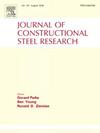含焊接孔缺陷的不锈钢十字形接头疲劳分析及性能评价
IF 4
2区 工程技术
Q1 CONSTRUCTION & BUILDING TECHNOLOGY
引用次数: 0
摘要
制备了预埋孔缺陷的不锈钢十字形焊接接头进行疲劳试验。建立了考虑母材和熔池材料不同疲劳性能的疲劳损伤演化有限元模型,验证了有限元分析方法的有效性。进一步研究了孔隙位置、孔隙大小和疲劳应力幅值对疲劳强度和破坏模式的影响。结果表明:不同孔隙位置可导致焊缝趾部和焊缝破坏模式,其疲劳强度分别为101.7 MPa和132.0 MPa;有限元疲劳损伤演化模型有效地预测了含孔缺陷的十字形不锈钢焊接接头试件的疲劳寿命。当孔位于熔池亚表面靠近焊趾处时,焊缝破坏最严重,导致焊缝在高应力幅值下出现破坏模式。最后,结合两种失效模式下的疲劳性能,提出了一种S-N曲线包络线来评价孔隙缺陷位置未知时的疲劳性能。本文章由计算机程序翻译,如有差异,请以英文原文为准。
Fatigue analysis and performance evaluation of stainless-steel-cruciform-joint with welding pore defect
Stainless steel cruciform welded joints with pre-embedded pore defects were fabricated for fatigue testing in this study. A finite element model for fatigue damage evolution, accounting for the different fatigue properties of the base metal and molten pool material, was established, and the validity of the finite element analysis (FEA) method was verified. The effects of pore location, pore size, and fatigue stress amplitude on fatigue strength and failure modes were further investigated. The results indicated that different pore locations might lead to weld toe and weld failure modes, with fatigue strengths of 101.7 MPa and 132.0 MPa, respectively. The FEA fatigue damage evolution model effectively predicted the fatigue life of cruciform stainless steel welded joint specimens with pore defects. The most detrimental position occurred when the pore was located in the sub-surface of the molten pool near the weld toe, resulting in weld failure modes under high stress amplitudes. Finally, by combining the fatigue performance under both failure modes, an S-N curve envelope was proposed to evaluate fatigue performance when the location of pore defects was unknown.
求助全文
通过发布文献求助,成功后即可免费获取论文全文。
去求助
来源期刊

Journal of Constructional Steel Research
工程技术-工程:土木
CiteScore
7.90
自引率
19.50%
发文量
550
审稿时长
46 days
期刊介绍:
The Journal of Constructional Steel Research provides an international forum for the presentation and discussion of the latest developments in structural steel research and their applications. It is aimed not only at researchers but also at those likely to be most affected by research results, i.e. designers and fabricators. Original papers of a high standard dealing with all aspects of steel research including theoretical and experimental research on elements, assemblages, connection and material properties are considered for publication.
 求助内容:
求助内容: 应助结果提醒方式:
应助结果提醒方式:


